 |
Washington (AFP) April 28, 2011 A handful of companies competing to make the spaceship to replace the iconic US shuttle said Thursday they are racing to shrink what will be a long gap in flying Americans into space aboard US craft. Boeing, SpaceX and Sierra Nevada Corporation were among the big winners of the latest round of US government funding, totaling 269.3 million dollars, through a NASA program to boost private companies' efforts. It will likely be 2015 before a US vehicle is ready to take humans into space again, a timeline that has been widely touted by NASA as a reason for American optimism as the 30-year-old shuttle program comes to an end later this year. But according to Mark Sirangelo, program manager at the Colorado-based Sierra Nevada Corp., his team could eke out a crew flight one year earlier with its Dream Chaser, modeled on a NASA design for a space station rescue vehicle. "Our vehicle has been in testing for 12 years," said Sirangelo, adding that atmospheric tests would begin in 2012 and the first orbital tests would follow in 2014. "By that time we would be crewed and ready in 2014," he said. Sierra Nevada won the largest amount of NASA seed money, $20 million, in the first round in 2010, and the second largest sum in the latest round of NASA contracts issued earlier this month at $80 million. SpaceX won $75 million in new seed money this year, after it became the first company to successfully send its own space capsule, the gumdrop-shaped Dragon, into orbit and back in December 2010. The California-based company sent newly hired ex-NASA astronaut Garrett Reisman to speak to reporters alongside competitor companies at Kennedy Space Center one day before Endeavour takes off on the second-to-last shuttle flight. "We are taking it to the next level," said Reisman, who smiled broadly after showing a slick animated video punctuated by electric guitar and pounding drumbeats, illustrating the company's progress in spaceflight. "The Falcon 9 rocket and the Dragon capsule were designed from day one to carry people," he said. "It is under contract and we have built this in cooperation with NASA." SpaceX is planning a cargo launch for the Dragon later this year, to "take it to the space station, dock it and unload it," he said. As to when the Dragon might carry astronauts, Reisman said it depends on funding. "We still believe we could have people in the Dragon three years from now, however we would need additional support from NASA," he said. Boeing won the biggest contract in this round with $92.3 million, and program manager John Elbon said the money would be used to advance its CST-100 spacecraft through the design review process with an eye to "full crew transport ability by 2015." "We are really focused on keeping it simple," said Elbon. "Having a simple system makes it safe and reliable and helps keep operational costs low." Blue Origin of Kent, Washington, got $22 million in funding, but its New Shepard vehicle is only being tested for sub-orbital flight "before we commit to orbital development," said company representative Rob Meyerson. Sirangelo said the NASA contract system sets competition in motion by paying companies only after they reach certain milestones. "It self adjusts -- those companies that are successful will continue to advance and those that do not will not get paid." The US space shuttle program is set to end later this year after the Atlantis launch in June. Then, Russian space capsules will be the sole method for bringing astronauts to the International Space Station and back. "The machine is not the most important," said Ed Mango, program manager for NASA's Commercial Crew Program. "It is the people and the intelligence behind the machine that makes the machine fly."
Share This Article With Planet Earth
Related Links Rocket Science News at Space-Travel.Com
 Russia To Develop New Space Rocket By 2015
Russia To Develop New Space Rocket By 2015Moscow, Russia (RIA Novosti) Apr 26, 2011 Russia is planning to develop a new carrier rocket by 2015 while continuing the work on the Angara family of space boosters, Prime Minister Vladimir Putin said on Wednesday. The Rus-M carrier rocket is being developed by the Energia space corporation, to launch new-generation spacecraft from the Vostochny space center currently under construction in the country's Far East. "We are pl ... read more |
|
| The content herein, unless otherwise known to be public domain, are Copyright 1995-2010 - SpaceDaily. AFP and UPI Wire Stories are copyright Agence France-Presse and United Press International. ESA Portal Reports are copyright European Space Agency. All NASA sourced material is public domain. Additional copyrights may apply in whole or part to other bona fide parties. Advertising does not imply endorsement,agreement or approval of any opinions, statements or information provided by SpaceDaily on any Web page published or hosted by SpaceDaily. Privacy Statement |